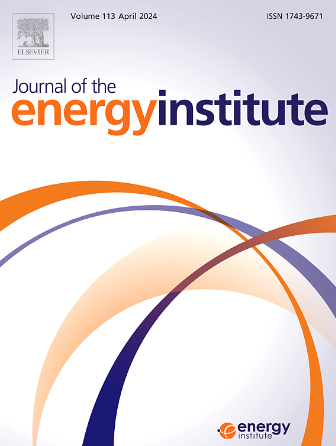Detailed molecular dynamic study on benzene decomposition and soot formation over Fe2O3(0 0 1) surface under external electric field (EEF) during chemical looping gasification
IF 6.2
2区 工程技术
Q2 ENERGY & FUELS
引用次数: 0
Abstract
Tar is an obstacle for biomass gasification industrialization. Tar catalytic decomposition over iron-based oxygen carrier under external electric field (EEF) was firstly studied using molecular dynamic method in this work. The results indicate that significant polymerization occurs during the pyrolysis of benzene, leading to the formation of large-molecular PAHs and soot. DFT calculation proves that EFF reduces that band gap of benzene from 0.24262 (without EEF) to 0.05755 (EFF = X+0.04a.u.), which indicates that intensive EEF will active benzene molecule largely by changing the polarization and the polarity. ReaxFF MD modeling results show that intensive EEF (0.5 V/Å and 1 V/Å) could inhibit to formation of soot as well as enhance the decomposition rate of benzene. EEF inhibits the polymerization reaction of benzene, and more small molecules (mainly hydrocarbons) are produced, in which hydrogen yield is inhibited. Fe2O3(0 0 1) surface could active benzene molecule by adsorbing hydrogen atom to form C6H5. At 2000K, the conversion rate of benzene reaches 86.8 % at 400ps in the presence of Fe2O3. EEF also affects the catalytic cracking of benzene. When the electric field intensity is 0.3 V/Å, the yield of CO is improved by 61.5 % compared with the pyrolysis without electric field. The combination of Fe2O3(0 0 1) and EEF could achieve high-efficient tar removal during chemical looping gasification of biomass.

电场作用下Fe2O3(0 0 1)表面苯分解及烟尘形成的分子动力学研究
焦油是生物质气化产业化的障碍。本文首次采用分子动力学方法研究了外电场作用下铁基氧载体上焦油的催化分解。结果表明,苯在热解过程中发生了明显的聚合反应,形成大分子多环芳烃和烟尘。DFT计算表明,EFF使苯的带隙从0.24262(无EEF时)减小到0.05755 (EFF = X+0.04a.u.),表明强EEF通过改变苯分子的极化和极性,在很大程度上激活了苯分子。ReaxFF MD模型结果表明,0.5 V/Å和1 V/Å的强电场可以抑制烟灰的形成,提高苯的分解速度。EEF抑制苯的聚合反应,产生更多的小分子(主要是碳氢化合物),从而抑制了氢的产率。Fe2O3(0 0 1)表面通过吸附氢原子生成C6H5活化苯分子。在2000K时,Fe2O3存在下,苯的转化率在400ps时达到86.8%。EEF对苯的催化裂化也有影响。电场强度为0.3 V/Å时,CO产率较无电场热解提高61.5%。在生物质化学环气化过程中,Fe2O3(0 0 1)与EEF的组合可实现高效除焦油。
本文章由计算机程序翻译,如有差异,请以英文原文为准。
求助全文
约1分钟内获得全文
求助全文
来源期刊

Journal of The Energy Institute
工程技术-能源与燃料
CiteScore
10.60
自引率
5.30%
发文量
166
审稿时长
16 days
期刊介绍:
The Journal of the Energy Institute provides peer reviewed coverage of original high quality research on energy, engineering and technology.The coverage is broad and the main areas of interest include:
Combustion engineering and associated technologies; process heating; power generation; engines and propulsion; emissions and environmental pollution control; clean coal technologies; carbon abatement technologies
Emissions and environmental pollution control; safety and hazards;
Clean coal technologies; carbon abatement technologies, including carbon capture and storage, CCS;
Petroleum engineering and fuel quality, including storage and transport
Alternative energy sources; biomass utilisation and biomass conversion technologies; energy from waste, incineration and recycling
Energy conversion, energy recovery and energy efficiency; space heating, fuel cells, heat pumps and cooling systems
Energy storage
The journal''s coverage reflects changes in energy technology that result from the transition to more efficient energy production and end use together with reduced carbon emission.
 求助内容:
求助内容: 应助结果提醒方式:
应助结果提醒方式:


